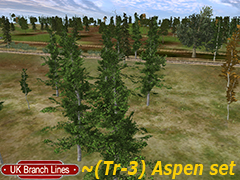Powered by AKR © Камиль Ахметзянов aka kemal, 2011 - 2024
| Поддержать проект | Форум trainz-mp.ru | Обратная связь (Ваш вопрос, Создание пакетов) | На наших часах: 19.12.2025 13:15:49 |
| Здравствуйте Гость ( Войти через форум ) Авторизовавшись Вы сможете загружать сюда любые зависимости формата .CDP для игры Trainz | Куиды Поиск |
 Тип: scenery
Тип: sceneryAspen tree (Populus tremula). Poly count 1267 (LOD0). It is a medium-sized deciduous tree growing to 10–25 m tall, with a trunk up to 1 m diameter. The bark is pale greenish-grey and smooth on young trees with dark grey diamond-shaped lenticels, becoming dark grey and fissured on older trees. The adult leaves, produced on branches of mature trees, are nearly round, slightly wider than long, 2–8 cm diameter, with a coarsely toothed margin and a laterally flattened petiole 4–8 cm long. The flat petiole allows them to tremble in even slight breezes, and is the source of its scientific name. The leaves on seedlings and fast-growing stems of root sprouts are very different, heart-shaped to nearly triangular, and often much larger, up to 20 cm long; their petiole is also less flattened. The flowers are wind-pollinated catkins produced in early spring before the new leaves appear; they are dioecious, with male and female catkins on different trees. The male catkins are patterned green and brown, 5–10 cm long when shedding pollen; the female catkins are green, 2–4 cm long at pollination, maturing in early summer to bear 10–20 capsules each containing numerous tiny seeds embedded in downy fluff. The fluff assists wind dispersal of the seeds when the capsules split open at maturity.
| asp_e_uvw_ch1-asp_e_uvw_ch1.texture.txt | 104 B |
| asp_e_uvw_ch1_nrm-asp_e_uvw_ch1_nrm.texture.txt | 115 B |
| bb3_color-bb3_color.texture.txt | 142 B |
| bb3_nrm-bb3_nrm.texture.txt | 95 B |
| bb4_color-bb4_color.texture.txt | 142 B |
| asp_e_uvw_ch1.tga | 1.0 MB |
| bb4_nrm-bb4_nrm.texture.txt | 95 B |
| bb3_nrm.tga | 1.0 MB |
| bb4_color.tga | 1.0 MB |
| asp_e_uvw_ch1_nrm.tga | 1.0 MB |
| bb4_nrm.tga | 1.0 MB |
| lod0.im | 103.9 kB |
| screenshot.jpg | 92.4 kB |
| bb3_color.tga | 1.0 MB |
| Общий объём файлов: | 6.2 MB |
| kuid | kind | name | build | date | size |
|---|---|---|---|---|---|
| <kuid2:328583:16162:1> | scenery | JVC~(Tr-3) Aspen G 19m. | 3.5 | 17.01.2021 0:46:06 | 2.2 MB |
| kuid | author | kind | name | build | date | size |
|---|---|---|---|---|---|---|
| Нет | ||||||
| kuid | author | kind | name | build | date | size |
|---|---|---|---|---|---|---|
| <kuid:44878:110827> | #44878 | map | alpine tunnel route Feb 28TH 2024 | 4.9 | 1.09.2025 3:27:38 | 135.0 MB |
| <kuid:57210:100047> | #57210 | map | Jacksonville Model RR (TMR17) | 4.4 | 21.09.2025 15:04:58 | 2.1 MB |
| <kuid:57210:100292> | #57210 | map | Bennett V2 | 3.7 | 3.09.2025 20:07:32 | 5.9 MB |
| <kuid:57210:100975> | #57210 | map | Jacksonville Model RR (TS12 only) | 3.7 | 22.09.2025 2:34:13 | 2.9 MB |
| <kuid:57210:102631> | #57210 | map | Grizzly Pass | 3.7 | 20.09.2025 4:16:04 | 4.2 MB |
| <kuid:57210:102663> | #57210 | map | Grizzly Pass | 3.7 | 21.09.2025 4:45:22 | 4.2 MB |
| <kuid:57210:103095> | #57210 | map | Echo Canyon | 3.7 | 15.09.2025 0:11:33 | 1.9 MB |
| <kuid:57210:104278> | #57210 | map | Bennett | 3.7 | 3.09.2025 18:26:29 | 5.9 MB |
| <kuid2:77568:1168:1> | #77568 | map | Kwa Zulu Natal Preservation Railways | 3.1 | 27.09.2025 2:31:37 | 3.5 MB |
| <kuid:94150:100010> | #94150 | map | DBtogether V2 | 3.7 | 10.09.2025 17:37:27 | 35.8 MB |
| <kuid:126090:100411> | #126090 | map | MRR:The South Park Line | 4.5 | 5.10.2025 15:03:51 | 403.3 kB |
| <kuid:126090:100645> | #126090 | map | MRR:The South Park Line TRS19 | 5 | 5.10.2025 17:13:57 | 459.2 kB |
| <kuid:126090:100646> | #126090 | profile | MRR:The South Park Line TRS19 - Default | 5 | 5.10.2025 17:16:23 | 229.5 kB |
| <kuid:151442:100366> | #151442 | map | DBtogether V2 | 3.7 | 11.09.2025 0:29:00 | 44.0 MB |
| <kuid:151442:100429> | #151442 | map | DBtogether - FRANCE V1 for TANE | 4.3 | 10.09.2025 18:05:35 | 72.7 MB |
| <kuid2:151442:100568:1> | #151442 | map | EUtogether V1 | 3.7 | 13.09.2025 1:48:35 | 153.9 MB |
| <kuid2:330526:100082:1> | #330526 | map | City Layout Extended | 3.3 | 29.08.2025 2:55:31 | 3.9 MB |
| <kuid:411884:102584> | #411884 | map | Libby to Yaak Mt. | 4.5 | 26.09.2025 13:31:51 | 44.3 MB |
| <kuid:429080:100009> | #429080 | map | DurangoToSilvertonTane_2 | 4.5 | 13.09.2025 10:54:51 | 123.2 MB |
| <kuid:429080:100045> | #429080 | map | DurangoToSilvertonTrainz22PE+_1895_2 | 5.6 | 13.09.2025 5:21:55 | 94.8 MB |
| <kuid:429080:100046> | #429080 | map | Durangoslvrtn_7-2.4 | 3.6 | 13.09.2025 12:02:57 | 115.9 MB |
| <kuid:429080:100126> | #429080 | map | DurangoToSilvertonTRS19_1895_1 | 5 | 13.09.2025 7:18:25 | 105.8 MB |
| <kuid2:429080:100162:2> | #429080 | map | DurangoToSilvertonTane_1895_ver.3 | 4.5 | 13.09.2025 11:02:43 | 127.2 MB |
| <kuid2:944855:100667:1> | #944855 | map | Osprey Lake TANE | 4.5 | 10.10.2025 13:15:06 | 1.4 MB |